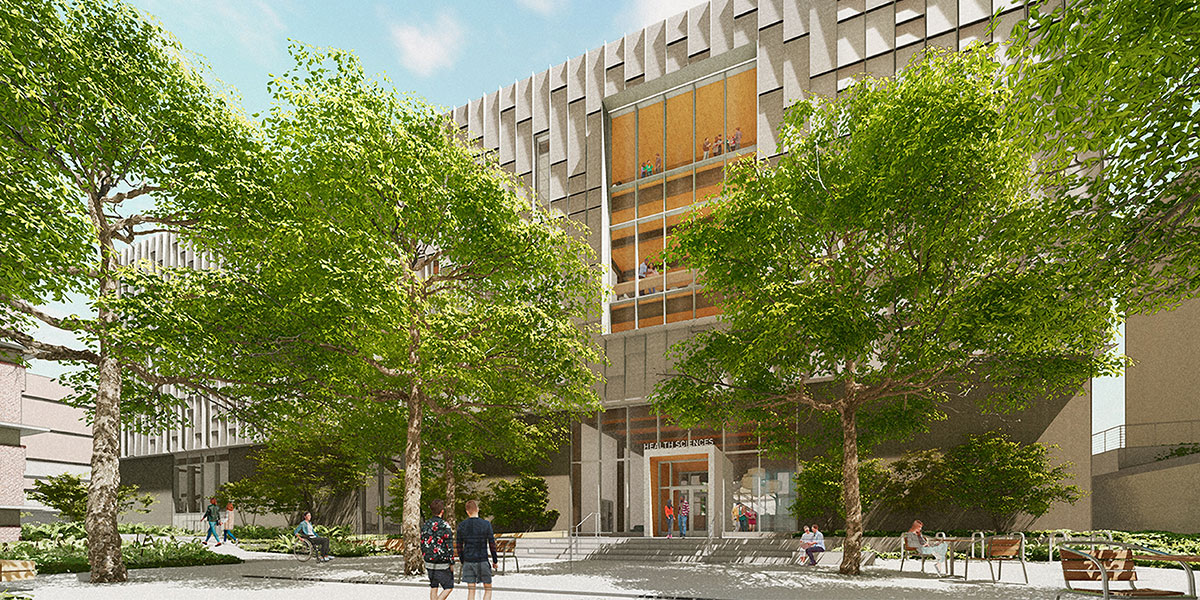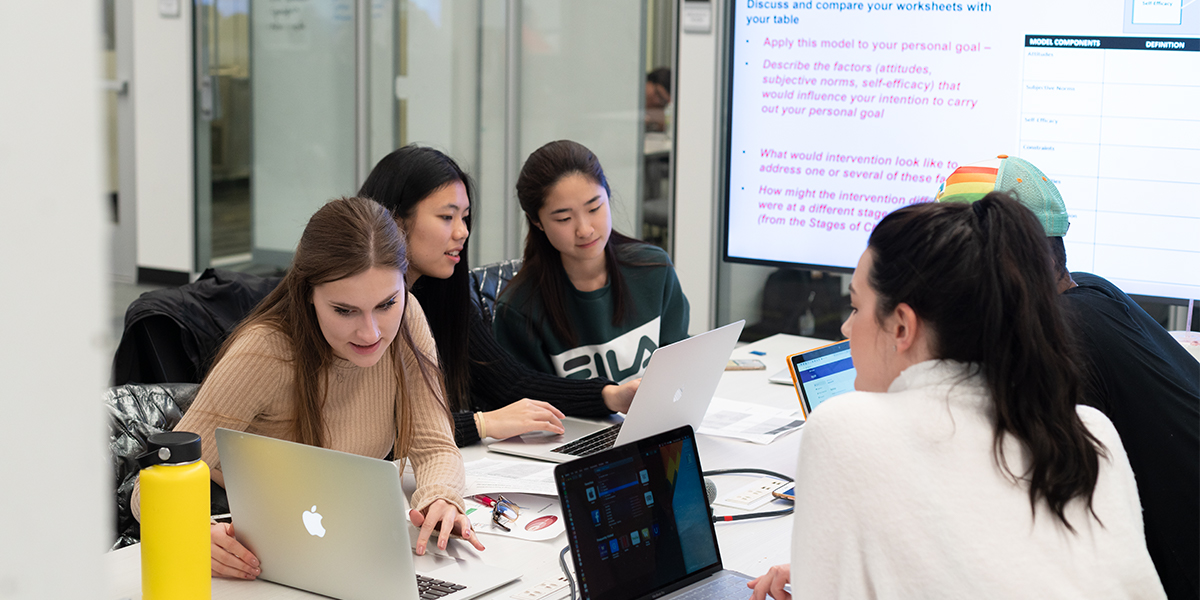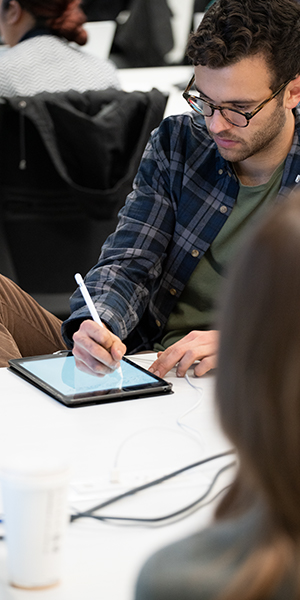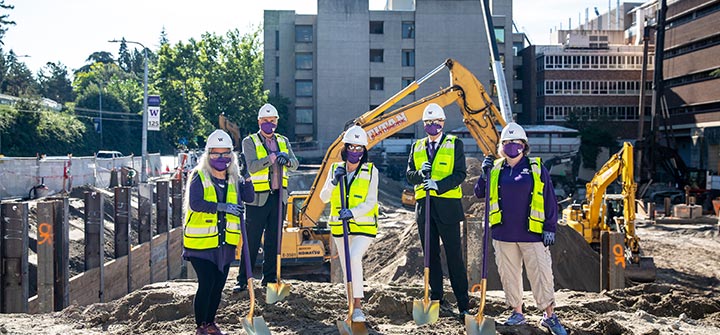
New health sciences building to feature active learning and cross-disciplinary education
Written by Meredith Bailey
Photos by Elizar Mercado
Hulking concrete structures with maze-like hallways and auditorium-style lecture halls are the architectural mainstays of many college campuses, but the University of Washington is intentionally constructing a different kind of space — one that invites collaboration, creativity and community.
The new Health Sciences Education Building, slated to open in 2022, will be nestled in the heart of south campus along Pacific Avenue. The 4-story, 110,000 square-foot building is designed to be a hub for all six health sciences schools, where students in dentistry, medicine, nursing, pharmacy, public health and social work can spend the day learning, both in and outside the classroom.
The building’s exterior will feature light-reflecting glass and metal surfaces, a courtyard and terrace, but what’s most striking is on the inside: an array of spaces — from large classrooms that accommodate up to 140 students to small breakout rooms for groups of eight — dedicated to active learning.
Designing a student-centered building that serves the needs of all the health sciences requires a lot of planning — including input from faculty, staff and students — as well as funding. The state of Washington has invested $70 million in the $100 million project. The university is seeking to raise an additional $30 million in gifts from the community. Opportunities are available for naming spaces in the building.
More Engagement, Better Outcomes

One way you know you are in an active learning classroom is by the sound. Rather than a single voice booming from behind a lectern, you’ll hear the low rumble of multiple voices, students quietly brainstorming, sharing feedback and asking questions. “The goal of active learning is to get students to learn with and from each other. You’re actually taking advantage of the fact that you’re all in a room together,” says Sara Mackenzie, teaching professor for the Department of Health Services.

For example, Mackenzie uses an active-learning technique called think-pair-share, where students first reflect individually on a question she has posed. Then they share their ideas with a partner or small group, before joining a discussion with the entire class. These types of active-learning techniques help students retain information and apply concepts to situations they are likely to encounter in the workplace. Active learning also presents opportunities for students to hone their speaking skills, particularly when discussing controversial topics.
Betelehem Tessema, an undergraduate student majoring in public health-global health, felt too intimidated to raise her hand in class when she first started college. “My interactive classes taught me how to speak up in larger groups,” says Tessema. “Plus, it’s really helpful to hear how other people are interpreting what we’re reading or what we’re doing.”
The new Health Sciences Education Building is designed with active-learning activities in mind. Classrooms will feature mobile tables and chairs that swivel to make it easier for students to converse with their neighbors. Multiple projection screens and whiteboards will be positioned around larger rooms. The classrooms will be distance-learning enabled, with care given to eliminate distractions, such as noise and inadequate lighting which is critical given that SPH and the other health sciences schools train students and provide continuing education training across not only the Pacific Northwest region, but also globally.
“Unlike a typical lecture hall with fixed, tiered seating, and maybe one screen that not everyone can see well, these classrooms are flexible, modern and designed for a multidirectional flow of information,” says Hilary Godwin, dean of the UW School of Public Health.
Teaming Up Across Disciplines

Team-based work facilitates learning among students in a class and across disciplines. An important focus of the six health sciences schools is interprofessional education (IPE): training students how to work together to improve the health of individuals and communities.
“I cannot think of a single job in public health where you just sit behind a desk and do your own work,” says Godwin. “To address the huge problems we’re facing as a society, like the opioid crisis, you have to be able to collaborate with all kinds of people. If we don’t train students how to do this now, then they won’t be prepared for success in the workforce.”
Collaboration in public health practice and in health care settings has not only become the norm but also reduces costs and enhances both the delivery and experience of care. “People across disciplines have different ways of seeing the world and bringing them together yields more innovation and advancement,” says Mackenzie. “That’s how you truly influence health outcomes.”
In addition to providing a variety of multidisciplinary-use classrooms, the new Health Sciences Building will feature an anatomy lab and “skills lab suite” where students across different programs can participate in clinical simulations and practice working toward common goals.
The building’s IPE commons is a place where students from all the health sciences can gather between classes to engage in discussions or group work. Other informal shared spaces include a quiet study area, a collaboration lobby, a communal kitchen and library.
“It’s not just about what happens in the classroom,” Godwin says. “We want students working together in diverse teams outside of class too, but to do that they need somewhere to congregate.”

Work on the new building began last summer and a formal groundbreaking ceremony was held on Aug. 27, 2020. As construction progresses, Godwin and other faculty members are brainstorming new educational possibilities. “We’re thinking about the ways we can leverage this space to develop new programs and to better meet the health needs of communities in our region and around the globe.”
Changing the meaning of 'teamwork' to improve health outcomes
By learning together in a shared building, health sciences students at the UW will learn to appreciate the different skills and expertise that individuals bring to an interdisciplinary health prevention, promotion and care team. This is a primary goal of the new Health Sciences Education Building.
“We want our students to get out of their territories to consider who else can help them do what’s right for their patients or the population,” says Peggy Odegard, professor and associate dean at the UW School of Pharmacy. Odegard works in diabetes care, an area she says benefits from this sort of awareness, trust and teamwork.
A cross-disciplinary approach to caring for patients with diabetes, which affects more than 460 million people worldwide, could lead to better health outcomes and reduce costs. Placing the patient at the center and involving physicians, nurses, pharmacists and dentists in their care could prevent heart attack and stroke, foot ulcers, blindness, kidney failure and poor oral health. Health administrators influence overall care quality and safety. Engaging social workers could ensure a patient’s access to health education, mental health care and services such as food assistance.
Importantly, stopping the diabetes epidemic will require collaboration with public health professionals who play a role in supporting proven interventions to prevent or delay the onset of diabetes, such as strategies that promote healthy nutrition and increase physical activity.
Public health experts also have a huge task in bringing about systemic change through advocacy and policy work, says Gary Chiodo, a public health dentist and dean of the UW School of Dentistry. They are key to ensuring that other health professionals and the U.S. health care system, in general, recognize upstream drivers of diabetes including income, education, housing and access to nutritious food and health care.
It is important that health sciences students understand this bigger-picture view and that they take it with them into their practice, according to Chiodo. “Learning alongside students in public health will catalyze that,” he says.
To learn more about supporting the new building and opportunities for recognition through naming a space, please contact Megan Kagel, associate dean for advancement at the UW School of Public Health, at mkingram@uw.edu or 206-616-7197. See a complete list of naming opportunities.